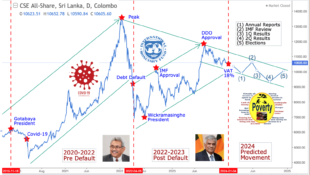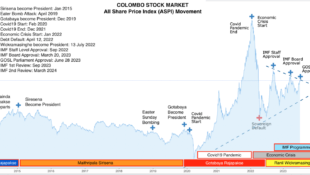The dark side of social media is that within seconds anything can be blown out of proportion and taken out of context. It is very difficult not to get swept up in it all” -Nicola Formichetti
Internet penetration in Sri Lanka has been increasing rapidly during the last few years. According to the Central Bank of Sri Lanka, the total Internet connections grew by 68.4 percent during 2014. As a result, social media has become a powerful and persuasive mode of communication. It has influenced our lives in all possible forms, including financial decision-making. Today’s article will focus on the nexus between social media and the local capital market. This is a formidable aspect that cannot be ignored if we are to maintain efficient markets.
What is social media?
Social media is a form of communication, a countless array of Internet-based tools and platforms that increase and enhance the sharing of information. This form of media transfers texts, photos, audio, video, etc. There is a myriad of social media platforms and it is important to brief ourselves on each of these types before we proceed with the discussion. (See Table 1)
Is social media a necessary evil?
One could not undermine the role of social media in shaping capital markets. It facilitates the quick exchange of information. One could argue that it creates a level playing field. Even investors who live in the outskirts of Colombo will be able to grasp the latest developments in the market. These developments do not necessarily have to be limited to the performance of the market. It could entail material information on investment decisions of high-net-worth investors, performance of companies, managerial decisions made by companies/stockbroker firms, professional networking, etc. This will enable investors to have a close watch on information and make required changes to maintain a profitable portfolio. When access to information is increased, an efficient price discovery mechanism could be expected. Social media also acts as a portal for discussion on vital topics. They can be rich in factual information and enable their readers to grow in knowledge.
Is social media a double-edged sword?
The distinct difference between social media and print/electronic media is that the former encapsulates vital informal information that is at times not verified. This enables us to question the credibility of the information shared.
The credibility of information released through social media is subjected to heavy criticism. A majority of social media is interactive and allows visitors to leave comments and even to chat with each other. This allows them to share whatever they feel without verifying the information. They do not have a fiduciary duty to the information they share. In such a situation, there is a possibility of sharing incorrect and inaccurate information. The market could be distorted if investment decisions are based on incorrect information.
It is observed that investor blogs play a decisive role in shaping investment decisions of local investors. Blogs can be an ideal platform for the investor community to discuss about the market. These blogs can also be used to evaluate market sentiments. However, many engage themselves in these blogs without a proper understanding on the functions of these web-based modes of communication. Anyone who becomes a member can share their views, information and predictions. In most cases, they use fake names in order to remain unanimous. At times it acts as a platform to exchange gossip. In such a context, it is easy for certain users to misuse these blogs. They can use it as a tool to misguide other investors in order to achieve their goals. Thus, it is important for investors to be vigilant when they are on social media.
Given in Figure 1 are extracts from various investor blogs in Sri Lanka. The names (user and the company) have been changed to maintain confidentiality.
How do people misuse social media?
Here are a few examples of the types of schemes you should be on the lookout for when using social media:
‘Pump-and-dumps’ and market manipulations
‘Pump-and-dump’ schemes may involve advertising a company’s stock through false and misleading statements on social media. These false claims could be made by urging readers to buy a stock quickly or to sell before the price goes down. Often the promoters will claim to have ‘inside’ information about the stock. At times they may be company insiders or paid promoters who gain by selling their shares after the stock price is ‘pumped’ up by the buying trend they create. Once these insiders ‘dump’ their shares and stop hyping the stock, the price typically falls and the innocent investors lose their money.
Fraud using ‘research opinions’
Usually you will come across research material when using social media. However, we should not forget that there can be a few isolated cases. In such situations, we might have to question the credibility of research opinions. Usually these opinions would lack reasoning but claim to be independent and unbiased recommendations.
Moving on, let’s move on to a practical aspect of what we discussed. There are ample examples from Sri Lanka to demonstrate how social media was manipulated by a few to achieve their hidden motives. Yet, the article will focus on foreign examples due to various technical reasons.
(See Box)
What can you do to shield yourself from social media?
Pragmatic investors cannot by any means refrain from using social media when investing. However, they can be vigilant about certain situations and thereby evade the dark side of social media. The key to shielding yourself is to be an educated investor.
Never invest hastily even if it seems attractive. Always check the credibility of the information.
Think twice if it sounds too good to be true. These messages are used to persuade investors to invest in stocks and push the price up. When you receive investment information through social media, verify the identity of the underlying source. Look for slight variations in the sender’s account name, profile, email address, screen name or other signs that might give signals about the intention of the sender.
Be cautious of unsolicited offers to invest. If you see a new post on a blog, a tweet mentioning you, a direct message or a Facebook message regarding a so-called investment opportunity, you should exercise extreme caution.
If it is a blog, verify the details of the administrator. Ideally the contact details of the administrator should be visible. If the administrator refrains from publishing contact details, a reasonable doubt arises about the credibility of the blog.
There is a higher possibility that recommendations that lack analysis can be a fraud. When recommendations are given on a hearsay basis make sure you verify the details. Even if the person is often seen in the blog or social sharing website, be sure to check out everything he says. Be aware that the person telling you about the investment may have been fooled into believing that the investment is genuine.
Be watchful of what is shared by new entrants. As you are aware, some may use social media to impersonate a popular market participant. For example, they may set up an account name and profile to mimic a particular company, high-net-worth investor, prominent investment advisor or securities research firm. It is also noticed that some who give false information on social media (blogs) are new to that particular mode of social media. They might enter the relevant social media, misguide investors and be silent for some time. Thus, it is always best to pay attention to the history of these people and analyse the type of information they share.
As responsible inventors, it is also important for the investors to refrain from blindly sharing information that you hear from others without verifying the information. At times you might support the hidden agendas of certain unethical market participants.
In conclusion, it is appropriate to restate that individuals are not liable for the information disseminated through social media. In most cases, it is impossible to even identify these individuals. Thus, investors should use social media with caution, if not fraudsters might manipulate it to attain their personal investment goals.
- See more at: http://www.dailymirror.lk/90899/social-media-and-the-sri-lankan-stock-market#sthash.80Yy2ES6.dpuf
 would enable you to enjoy an array of other services such as Member Rankings, User Groups, Own Posts & Profile, Exclusive Research, Live Chat Box etc..
would enable you to enjoy an array of other services such as Member Rankings, User Groups, Own Posts & Profile, Exclusive Research, Live Chat Box etc.. 
 Home
Home





















